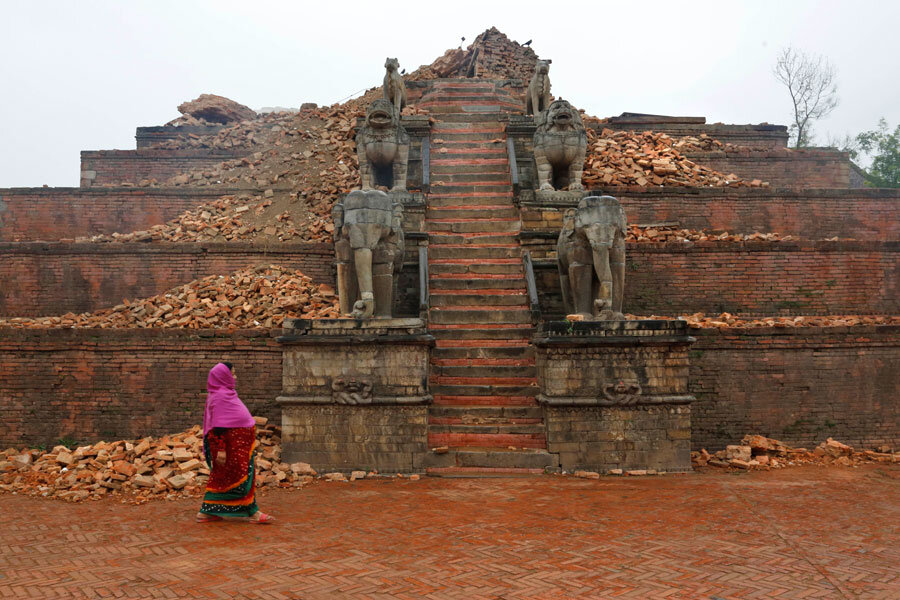Nepal quake: 'Shangri-la' tourism takes heavy hit
Loading...
| KATHMANDU, NEPAL
Beyond killing more than 7,000 people and causing billions of dollars in damage, the April 25 earthquake in Nepal delivered a major blow to an already beleaguered tourism industry.
From crumbled ancient temples to debris-blocked mountain roads, the destruction wrought by the quake is ubiquitous. Foreign tourists, on the other hand, are increasingly few and far between – and it's unclear when they’ll return.
“The earthquake affected everything that tourists come for in Nepal,” says Dambar Parajuli, president of the Expedition Operators’ Association, which represents Mount Everest Sherpas. “The industry will take years to recover.”
Tourism provides hundreds of thousands of jobs and accounts for 8 percent of the Nepal’s economy, according to the Asian Development Bank. Last year, nearly 800,000 people visited the country, home to eight of the world’s 14 tallest peaks and dozens of world heritage sites.
The 7.8-magnitude quake was the third major disaster to hit Nepal, one of Asia’s poorest countries, in a little over a year. Last April an avalanche on Mt. Everest killed 16 Sherpas. Then came the massive snowstorm in October that killed more than 40 people along the Annapurna trekking trail.
Much like the first two disasters, this month's earthquake struck Nepal during the peak tourism season. Police reported Sunday that at least 54 foreigners have been found dead and that an additional 109 are still missing. Avalanches and landslides triggered by the quake have severely damaged hiking routes – including the one that leads up Mt. Everest – and destroyed family-owned lodges.
Of the roughly 800 climbers who were on Mt. Everest when the quake hit, at least 18 were killed. Nepalese tourism officials insist that the world’s highest peak will stay open. But the spring climbing season appears likely to be cut short for the second year in a row as many of the top guide companies have cancelled trips.
Lost heritage sites
The quake also took a heavy toll on ancient landmarks in the Kathmandu Valley. The valley is home to seven UNESCO World Heritage sites, three of which were almost entirely destroyed by the quake, according to the Department of Archeology.
At least three dozen temples and monuments ornamented with gilded brass, bronze, and intricately carved wood – representing a unique fusion of Hindu and Buddhist architecture – have collapsed, wiping out cultural heritage dating back to as early as the 12th century.
Ram Bahadur Kunwar, a spokesman for the Department of Archeology, says the worst hit sites are Kathmandu's Durbar Square and the Changu Narayan temple. He says the main shrine at Swayambhunath – one of the oldest and most sacred Buddhist sites in the valley – remains intact, but that surrounding structures were heavily damaged.
Iswari Poudel, who runs a trekking agency in Kathmandu, says he believes tourists will understand what happened couldn’t have been prevented, but that they will want an explanation for why the response to the earthquake and two previous disasters has been so poor.
“We have only one international airport and very limited resources that can be mobilized for search, rescue, and relief,” says Mr. Poudel. “This is a serious handicap during disasters like those that have hit Nepal since last year.”
Preparing for emergencies
Tulasi Prasad Gautam, director general of Nepal’s Tourism Department, says among the biggest challenges will be regaining the trust of foreign tourists.
“We can repair trekking routes in six months,” he says. “But to address the psychological damage, we will have to gather resources and convince prospective tourists that we are prepared for emergencies like these.”
Prachanda Man Shrestha, former CEO of the Nepal Tourism Board, says the country can no longer rely on its “Shangri-la image” that has lured tourists for decades.
“That image has been scarred now,” he says. “If Nepal’s tourism is to recover and grow, there now has to be deliberate intervention to motivate tourists to come. Smart and attractive tourism packages will be needed and there has to be a visible mechanism to make tourists feel safe.”
While the Nepalese government is likely to focus its energy on supplying aid to devastated areas for weeks or possibly even months ahead, officials have vowed to eventually rebuild the lost temples and monuments. Mr. Kunwar says the Department of Archeology has blueprints of each one and that rebuilding them will take five to six years.
In the meantime, tourism officials hope foreigners will keep coming to Nepal. “If not for anything else then to boost the morale of this devastated nation,” Parajuli says.







